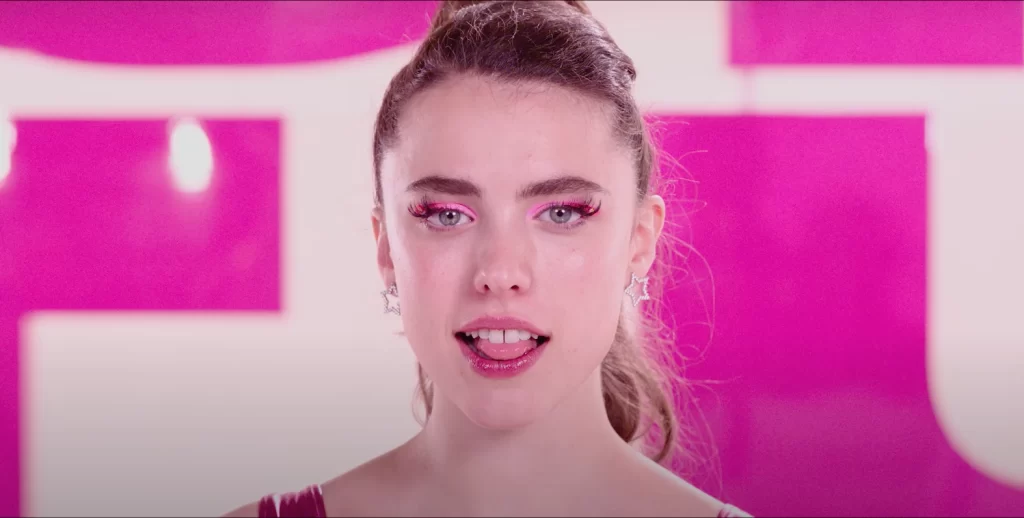
Coralie Fargeat’s first feature, about a female plaything who gets used up and left for dead only to rise from the metaphorical ashes and transform into a retaliatory angel, was aptly called Revenge. The same title might also apply to The Substance, Fargeat’s explosive, provocative, and decidedly gonzo follow-up of feminist reduction and wrath. Revenge, one of the best movies of 2018, was memorable in part for how it kept things small; its taut, sharp setting, involving just a handful of people and locations, imbued its typical thriller construction with an elemental ferocity. In quantitative terms, The Substance is similarly intimate—there are only two characters of any depth—but its scope is far more expansive, creating an intricate mythology while taking satirical aim at the boys’-club institution that is Hollywood. The target of Fargeat’s vengeance is no longer one man but the male gaze altogether.
What persists, beyond an undercurrent (overcurrent?) of righteous anger, is her supple craftsmanship. The Substance is a big movie full of garish violence and sweeping ideas, but its images are composed with elegance and precision. Consider its first few scenes. The ominous opening shot finds an unknown hand pumping a liquid into the curdled yolk of a fried egg, which then magically belches out another foodstuff that looks nearly identical, except that it’s slightly more pristine; as your eye takes pleasure in the contrasting colors—the yellow yolk sits on a complementary sky-blue surface, while the fluid is a distinctive puke-green—your brain instantly downloads both the film’s inherent mystery and its thematic preoccupation with doubling. Then comes the time-lapsed overhead view of a Walk of Fame star, progressing from its flawless manufacture to its gradual disintegration: the life cycle of a Hollywood starlet, distilled into a few cracks of stone. Without moving her camera or opening her mouth, Fargeat has primed you for her ensuing fable about the perils of female aging in Tinseltown.

The name emblazoned on that star is Elisabeth Sparkle, a one-time A-lister turned workout-video shill who is played, in a delicious piece of casting that lends the movie its meta kick, by Demi Moore. “At 50, well, it stops,” says Elisabeth’s network producer (Dennis Quaid, turned up to 11) while stuffing seafood into his face. The exact antecedent of his axiom is never specified—is it stardom? beauty? charisma?—but shave 15 years off his statement, and it seems to be an accurate assessment of Moore’s career. For most of the ’90s, she was a reliable presence in mid-budget dramas that appealed to adult audiences; they weren’t always good, but they were mainstream productions and she was a major name. Then she turned 35 and, well, everything stopped. (Her smattering of leading roles in the time since includes ignominious titles such as Passion of Mind, Half Light, and Blind.) The Substance represents less a comeback vehicle than a venting of rage—a pent-up howl, 26 years in the making, at the industry that discarded her.
I don’t know that Moore was ever a great actress. I don’t even know that she’s great in The Substance, aside from one extraordinary sequence (we’ll get to that). I do know, or at least I’m firmly convinced, that her dispiriting professional arc—the familiar pattern of an attractive woman whose star power dwindles as her body withers, consigning her to the stock parts of mother or crone—is the animating spirit behind Fargeat’s anger, which she conveys with all the subtlety of a banshee’s scream. Is it uncouth to ding her screenplay (which won at Cannes) for its bluntness, given that its insights tend to be less piercing than merely obvious? It isn’t exactly news at this point that Hollywood treats women badly as they age, so repeated scenes of old white men exhorting ladies to smile are as likely to have you rolling your eyes as shaking your fist. There’s a nice early touch where Elisabeth receives a farewell card that reads, “You were amazing!”; unable to stop herself, Fargeat provides a close-up of the middle word, emphasizing its past tense in blaring capital letters.

Jeez, girl, don’t be so shrill! I’m kidding. Besides, Fargeat’s outspoken approach to her themes is of a piece with her maximalist mode of storytelling, even if her technique is deceptively graceful. The basic hook of The Substance is devilishly intriguing: Elisabeth, dismissed from her morning-show gig and reckoning with her looming irrelevance (we see a billboard of her face being unceremoniously shredded), catches wind of the titular material: a simple goo designed to produce “a better version of yourself”—a younger and more beautiful you whom you then trade places with every week. It’s silly stuff on the page, but Fargeat communicates the logistical workings of the invention—a raft of vials, syringes, and neatly lettered packages—with such crisp efficiency that you don’t worry about suspending your disbelief. Instead, you just watch in amazement as Elizabeth takes a swig of liquid and then collapses to the floor, at which point her spinal cord turns into a birth canal, out from which pops a looker who calls herself Sue (Margaret Qualley).
Ignore the truck sequence from Furiosa, and the “activation” scene in The Substance would be an instant contender for scene of the year. On one level, it is pure Cronenbergian body horror: distended limbs, squelching fluids, shrieks of pain. Yet it is also oddly rapturous and even tender, conveying wonderment at the marvel of (in)human creation. When Sue emerges, she eyes herself in the mirror—that flattering, unforgiving fixture which Fargeat’s characters stare into intently and repeatedly—with deep satisfaction. She also spies Elisabeth’s crumpled vessel on the floor and instinctively goes about preserving her, a strangely affectionate process involving stitches and feeding tubes. For a brief moment, these two gorgeous women—who are, in the script’s conception, technically the same person—achieve a blissful symbiosis.

It is hardly a spoiler to declare that this mutual contentment doesn’t last. The narrative trajectory of The Substance is broadly predictable—shit hits the fan, as do other excretions—but the movie remains consistently engaging, thanks to the actors’ limber performances and Fargeat’s exquisite sense of style. The film is resplendent with gleaming surfaces that pop in bold colors: the bright white of a bathroom, the burnt orange of a hallway, the vivid yellow of Elisabeth’s coat. (The costumes are by Emmanuelle Youchnovski; the production designer is Stanislas Reydellet.) Yet no object receives greater adoration than Qualley’s body, which the camera captures with indecent zeal. Armed with a revealing pink leotard and a supremely confident bearing, Sue strides into the office of Elisabeth’s erstwhile employer and immediately claims her old job, making her both a rising star and a potential victim. In this universe, a woman’s greatest achievement is to be the subject of sexy, sweaty exploitation.
Naturally, this fetishism doesn’t sit well with Elisabeth, who finds her existence even emptier than before. The quiet tragedy of The Substance is that what begins as an ostensible partnership—Elisabeth created Sue to be rewarded, not supplanted—instead becomes a cruel zero-sum game, one in which Sue’s ascension comes at the cost of Elisabeth’s degradation. (The billboard across from their apartment quickly bears Sue’s face, a giant, taunting reminder of Elisabeth’s own insignificance.) Curiously, the movie reaches its thematic peak well before its finale, during a haunting sequence in which Elisabeth resolves to go out on a date, only to constantly pause to redo her makeup. The moment where she starts to leave her apartment, only to catch a glimpse of herself in the doorknob’s reflection and freeze, is devastating in its crippling self-doubt.

But about that finale: In its closing passages, The Substance goes full Grand Guignol; blood sprays wildly, body parts shrivel and fuse, and at one point a chicken leg gets yanked out of a belly button. It’s a lot, and it’s hard to know what to make of it. On one hand, there is a measure of bravery in Fargeat’s decision to follow her premise all the way into the wilderness. On the other, the overkill can be enervating, diluting the force of Fargeat’s filmmaking and numbing you with senseless extremity.
I suppose what I’m asking for is a sharper, tighter version of The Substance—you know, the same, only better. What could go wrong? But while this may be an imperfect movie, it is also an inimitable one, possessing a singular identity along with a consummate level of ingenuity. It will not go quietly, and it will not be copied.
Grade: B+
Jeremy Beck is the editor-in-chief of MovieManifesto. He watches more movies and television than he probably should.
